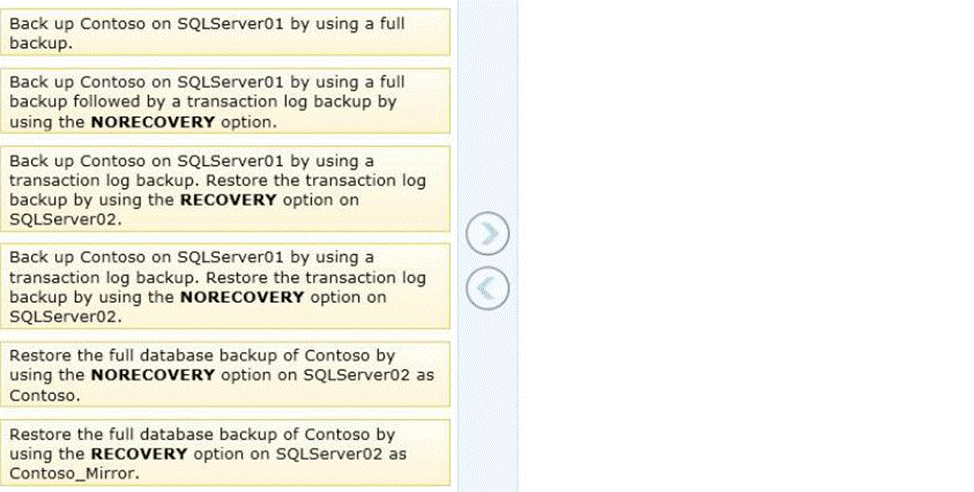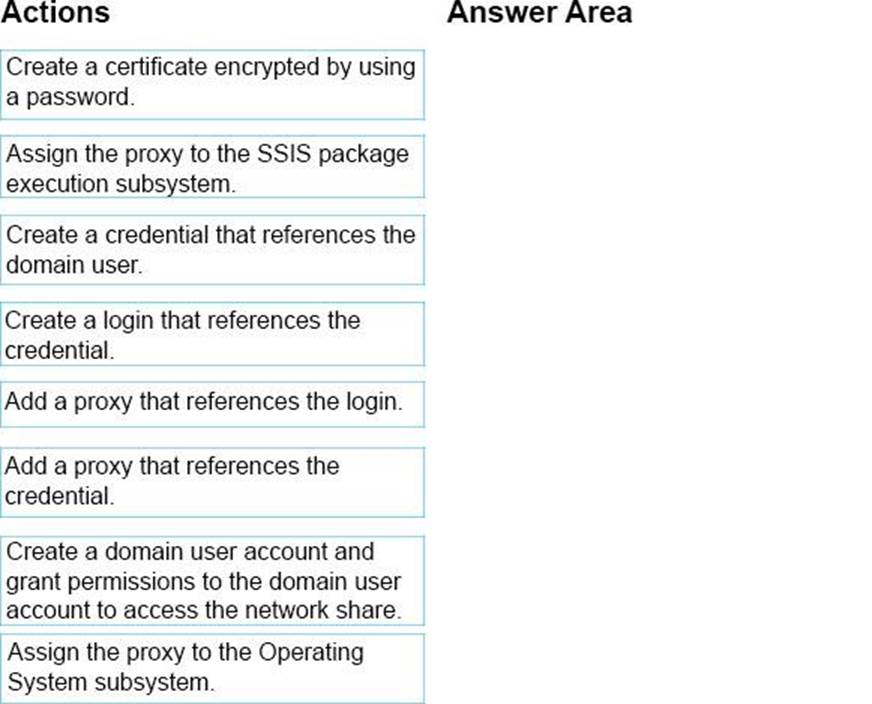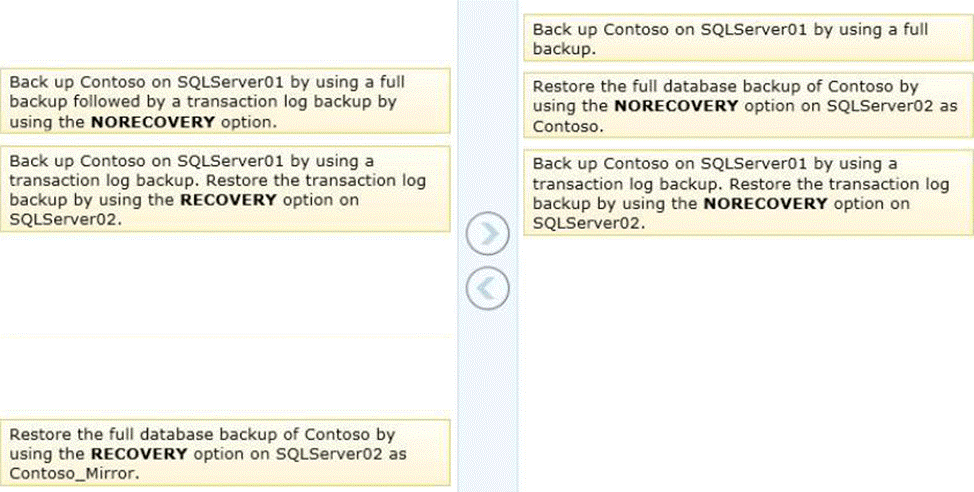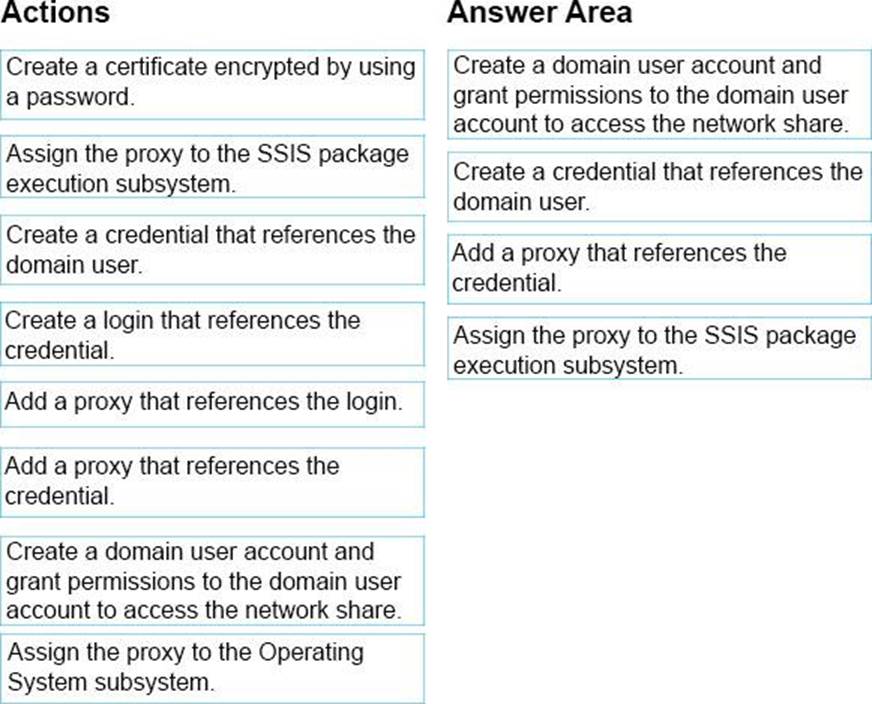Microsoft 70-462 Administering Microsoft SQL Server 2012 Databases Online Training
Microsoft 70-462 Online Training
The questions for 70-462 were last updated at Jan 23,2025.
- Exam Code: 70-462
- Exam Name: Administering Microsoft SQL Server 2012 Databases
- Certification Provider: Microsoft
- Latest update: Jan 23,2025
DRAG DROP
You are a database administrator of a Microsoft SQL Server 2012 environment. The environment contains two servers named SQLServer01 and SQLServer02. The database Contoso exists on SQLServer01.
You plan to mirror the Contoso database between SQLServer01 and SQLServer02 by using database mirroring.
You need to prepare the Contoso database for database mirroring.
Which three actions should you perform in sequence? (To answer, move the appropriate actions from the list of actions to the answer area and arrange them in the correct order.)

You create an availability group that has replicas named HA/Server01 and HA/Server02. Currently, HA/Server01 is the primary replica.
You have multiple queries that read data and produce reports from the database.
You need to offload the reporting workload to the secondary replica when HA/Server01 is the primary replica.
What should you do?
- A . Set the Availability Mode property of HA/Server02 to Asynchronous commit.
- B . Set the Readable Secondary property of HA/Server02 to Read-intent only.
- C . Set the Connections in Primary Role property of HA/Server01 to Allow read/write connections.
- D . Set the Availability Mode property of HA/Server01 to Asynchronous commit.
You administer two Microsoft SQL Server 2012 servers. Each server resides in a different, untrusted domain. You plan to configure database mirroring. You need to be able to create database mirroring endpoints on both servers.
What should you do?
- A . Configure the SQL Server service account to use Network Service.
- B . Use a server certificate.
- C . Use a database certificate.
- D . Configure the SQL Server service account to use Local System.
You administer a Microsoft SQL Server 2012 instance that has several SQL Server Agent jobs configured.
When SQL Server Agent jobs fail, the error messages returned by the job steps do not provide the required detail.
The following error message is an example error message:
"The job failed. The Job was invoked by User CONTOSOServiceAccount. The last step to run was step 1 (Subplan_1)."
You need to ensure that all available details of the job step failures for SQL Server Agent jobs are retained.
What should you do?
- A . Configure output files.
- B . Expand agent logging to include information from all events.
- C . Disable the Limit size of job history log feature.
- D . Configure event forwarding.
DRAG DROP
You administer a Microsoft SQL Server database. Service accounts for SQL Agent are configured to use a local user.
A Microsoft SQL Server Integration Services (SSIS) job step has been created within a SQL Server Agent job.
The SSIS package accesses a network share when exporting data from a SQL Server database.
When you execute the SQL Server Agent job, it fails due to a permissions failure on a share on a remote server.
You need to ensure that the SQL Server Agent job can execute the SSIS package.
Which four actions should you perform in sequence? (To answer, move the appropriate actions from the list of actions to the answer area and arrange them in the correct order.)

You administer a Microsoft SQL Server instance. You need to configure a new database to support FILETABLES.
Which three actions should you perform? Each correct answer presents part of the solution.
- A . Disable FILESTREAM on the Database.
- B . Enable FILESTREAM on the Server Instance.
- C . Configure the Database for Partial Containment.
- D . Create a non-empty FILESTREAM file group.
- E . Enable Contained Databases on the Server Instance.
- F . Set the FILESTREAM directory name on the Database.
You administer two instances of Microsoft SQL Server. You deploy an application that uses a database on the named instance.
The application is unable to connect to the database on the named instance.
You need to ensure that the application can connect to the named instance.
What should you do?
- A . Configure the application as data-tiered.
- B . Open port 1433 on the Windows firewall on the server.
- C . Configure the named SQL Server instance to use an account that is a member of the Domain Admins group.
- D . Start the SQL Server Browser Service.
You use a contained database named ContosoDb within a domain.
You need to create a user who can log on to the ContosoDb database. You also need to ensure that you can port the database to different database servers within the domain without additional user account configurations.
Which type of user should you create?
- A . SQL user without login
- B . User mapped to an asymmetric key
- C . Domain user
- D . login mapped to a virtual account
You administer a Microsoft SQL Server 2012 database.
You configure Transparent Data Encryption (TDE) on the Orders database by using the following statements:
CREATE MASTER KEY ENCRYPTION BY PASSWORD = ‘MyPassword1!’
CREATE CERTIFICATE TDE_Certificate WITH SUBJECT = ‘TDE Certificate’;
BACKUP CERTIFICATE TDE_Certificate TO FILE = ”d:TDE_Certificate.cer’
WITH PRIVATE KEY (FILE = ‘D:TDE_Certificate.key’, ENCRYPTION BY PASSWORD = ‘MyPassword1!’);
CREATE DATABASE ENCRYPTION KEY
WITH ALGORITHM = AES_256
ENCRYPTION BY SERVER CERTIFICATE TDE_Certificate;
ALTER DATABASE Orders SET ENCRYPTION ON;
You attempt to restore the Orders database and the restore fails. You copy the encryption file to
the original location.
A hardware failure occurs and so a new server must be installed and configured.
After installing SQL Server to the new server, you restore the Orders database and copy the encryption files to their original location.
However, you are unable to access the database.
You need to be able to restore the database.
Which Transact-SQL statement should you use before attempting the restore?
- A . ALTER DATABASE Master SET ENCRYPTION OFF;
- B . CREATE CERTIFICATE TDE_Certificate FROM FILE = ‘d:TDE_Certificate.cer’
WITH PRIVATE KEY (FILE = ‘D:TDE_Certificate.key’, DECRYPTION BY PASSWORD =
‘MyPassword1!’); - C . CREATE CERTIFICATE TDE_Certificate WITH SUBJECT = ‘TDE Certificate’;
USE Orders;
CREATE DATABASE ENCRYPTION KEY
WITH ALGORITHM = AES_256
ENCRYPTION BY SERVER CERTIFICATE TDE_Certificate; - D . CREATE CERTIFICATE TDE_Certificate FROM FILE = ‘d:TDE_Certificate.cer’;
Note: This question is part of a series of questions that use the same set of answer choices. An answer choice may be correct for more than one question in the series.
You administer a SQL Server 2012 server that contains a database named SalesDB. SalesDb contains a schema named Customers that has a table named Regions. A user named UserA is a member of a role named Sales.
UserA is granted the Select permission on the Regions table. The Sales role is granted the Select permission on the Customers schema.
You need to ensure that the Sales role, including UserA, is disallowed to select from any of the tables in the Customers schema.
Which Transact-SQL statement should you use?
- A . REVOKE SELECT ON Schema::Customers FROM UserA
- B . DENY SELECT ON Object::Regions FROM UserA
- C . EXEC sp_addrolemember ‘Sales’, ‘UserA’
- D . DENY SELECT ON Object::Regions FROM Sales
- E . REVOKE SELECT ON Object::Regions FROM UserA
- F . DENY SELECT ON Schema::Customers FROM Sales
- G . DENY SELECT ON Schema::Customers FROM UserA
- H . EXEC sp_droprolemember ‘Sales’, ‘UserA’
- I . REVOKE SELECT ON Object::Regions FROM Sales
- J . REVOKE SELECT ON Schema::Customers FROM Sales
Latest 70-462 Dumps Valid Version with 301 Q&As
Latest And Valid Q&A | Instant Download | Once Fail, Full Refund



